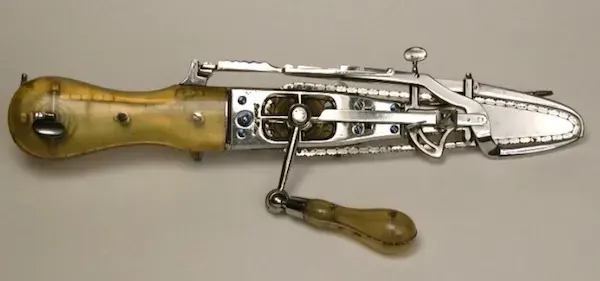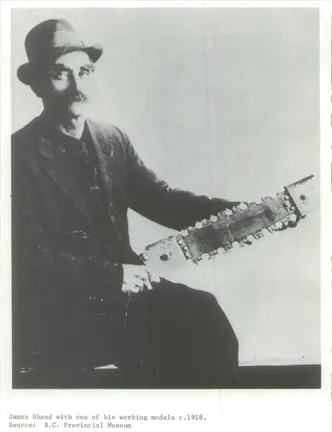Why Were Chainsaws Invented?
- January 16, 2024
- 0 comment
When you hear the word “chainsaw,” the immediate image that comes to mind is likely one of the powerful tools used for cutting down trees. However, the chainsaw’s origins are far from the wooded forests and timber fields. Its history is interwoven with medical advancements and the ever-evolving science of surgery. In this article, we’ll explore the fascinating journey of the chainsaw, from a surgical instrument to its modern role in forestry and woodcutting.
Why Were Chainsaws Invented for Medical Use?
Chainsaws were originally invented to assist in childbirth during difficult deliveries in the 18th century, specifically to widen the birth canal.

In the late 18th century, childbirth was a perilous process. With cesarean operations not yet a viable option, doctors faced significant challenges, especially in cases of oversized or breech babies. The prevalent method involved manually widening the birth canal, a procedure that was not only time-consuming but excruciating for the mother, as anesthesia wasn’t available.
Enter Scottish doctors James Jeffery and John Aitken in 1782, who sought to alleviate the pain and duration of such procedures. Their solution was groundbreaking: a prototype chainsaw. Contrary to what we might imagine, this chainsaw resembled a kitchen knife more than the bulky tool we know today. It was equipped with a hand crank to rotate its blade, making it smaller, more precise, and significantly more efficient than the knives or saws previously used.
The Evolution of Chainsaws from Medical to Forestry Tools

Meanwhile, in Germany in 1830, Bernhard Heine observed similar limitations in the surgical tools available for bone cutting. He developed the “osteotome” a handheld tool with a chain containing sharp teeth, designed to make bone surgery less cumbersome and more precise. While Heine’s invention was independent of the earlier Scottish development, it shared the same principle of using a chain for cutting.
Chainsaws in the Timber Industry

In this innovative climate, the first chainsaw designed explicitly for woodcutting emerged under the patent of Samuel Benz from San Francisco in 1905. This initial foray, while groundbreaking, was marred by the chainsaw’s bulky and unwieldy nature, a stark contrast to the streamlined and efficient models we are accustomed to today. The real breakthrough came in 1918, when a visionary Canadian millwright named James Shand unveiled a more portable and practical version, radically transforming the woodcutting industry. However, it was ultimately Festo, a German company, who seized the opportunity presented by the lapse of Shan’s patent, effectively laying the groundwork for the development of the modern chainsaw.
From Bones to Trees
The pioneering effectiveness of these early chainsaws in the realm of bone surgery captured the attention of other industries. In an era where the timber industry was experiencing a significant boom, there was an incessant quest for tools that could enhance efficiency and magnify output. The ingenious design of the chainsaw, already proven effective in the medical field, presented an alluring potential for adaptation to woodcutting.
STIHL: Pioneers in Chainsaw Manufacturing
At the forefront of these advancements stood STIHL, now recognized as the oldest existing chainsaw manufacturer. Their pivotal role in refining and advancing both the design and functionality of chainsaws has been instrumental. Under their aegis, the chainsaw evolved from a crude cutting device into a sophisticated tool synonymous with woodcutting and tree felling, a testament to the brand’s innovation and enduring legacy.
Why Were Chainsaws Made for Forestry?
The transformation of the chainsaw into the modern tool we recognize today primarily occurred in the 1920s. This era is marked by significant contributions from three key innovators: Wolf in the USA, Westfelt in Sweden, and Stihl in Germany. Stihl, established in 1926 and boasting an impressive annual turnover of 1.6 billion Euros by 2004, has the distinction of being the world’s largest and oldest chainsaw producer.
The initial motivation behind this wave of innovation was to alleviate the heavy burden of forestry work. The introduction of machinery into this sector was aimed at boosting productivity and profit, a goal that would soon revolutionize forestry practices.
History of chainsaws
- 1926: Stihl introduces the first electric chainsaw.
- 1927: Dolmar unveils the first petrol-powered chainsaw.
- 1950: The debut of the first one-man chainsaw.
- 1964: Chainsaws are enhanced with an antivibration system.
- 1972: Integration of a chain brake into the chainsaw’s design.
- 1982: Addition of the quick-stop feature, an automatic chain brake.
- 1989: Introduction of the Catalyzer.
- 1991: Development of automatic start features.
The late 1920s saw the advent of the first petrol chainsaws. Initially, these were designed for two-person operation, mirroring traditional saws and accommodating technical limitations. The earliest two-man chainsaws weighed over 60 Kilos, a significant challenge that spurred further innovation. The goal was clear: to create a lighter, more powerful saw that could be operated by a single person.
By 1950, the first one-man chainsaw was introduced, although it was still quite heavy, weighing around 12 Kg. In contrast, modern chainsaws weigh approximately 4-5 kg, with heavy-duty models ranging between 7 and 9 kg. The transition to one-man chainsaws was a significant milestone, changing the soundscape of forestry from traditional sawing to the rattling of chainsaws.
The end of the 1950s also saw a shortage of lumberjacks, sparking hopes that chainsaws would make forestry work more appealing to the younger generation. However, the journey of the chainsaw in the forestry industry was not without its challenges. Early models were cumbersome, prone to breakdowns, and required considerable energy to operate, even in two-person configurations.
Despite these initial obstacles, the chainsaw gradually established itself as an indispensable tool in forestry. Its journey was marked by debates and resistance, similar to the earlier transition from axes to saws. For instance, in 1957, there were contentions about the efficiency of chainsaws in transporting pine wood and arguments favoring traditional axe methods for clean-cut debranching. The increased efficiency of chainsaws also led to changes in piecework rates, causing some lumberjacks to revert to hand saws.
Conclusion
The chainsaw’s journey from a surgical tool to a “monster tool” for felling trees is a testament to human ingenuity and adaptability. It’s a reminder of how inventions can transcend their original purpose, evolving over time to meet the changing needs of society. From aiding in the miracle of childbirth to shaping the landscape of forestry, the chainsaw has carved out a unique place in both medical and industrial history.
FAQs
- How did the early medical chainsaw differ from today’s woodcutting chainsaw?
The early medical chainsaw was smaller and hand-cranked, resembling a kitchen knife. In contrast, today’s chainsaws are motorized and designed for heavy-duty cutting. - What was the primary medical procedure that led to the invention of the chainsaw?
The chainsaw was originally invented to assist in childbirth, specifically for the procedure of symphysiotomy, which involved widening the birth canal in difficult labor cases. - Who were the key inventors in the development of the chainsaw?
The chainsaw’s development involved several key figures, including Scottish doctors James Jeffery and John Aitken, and later, German doctor Bernhard Heine with his osteotome. - Was the chainsaw initially accepted in the medical community?
Yes, the early version of the chainsaw was quickly adopted by the medical community due to its efficiency and precision in bone cutting, marking a significant advancement in surgical tools at the time. - How did the chainsaw transition from a medical tool to a forestry tool?
The chainsaw’s effectiveness in cutting bone led to the realization that it could be adapted to cut wood. This transition was driven by the demands of the booming timber industry for more efficient cutting tools. - When did the first chainsaw designed specifically for woodcutting appear?
The first chainsaw designed specifically for woodcutting was patented by Samuel Benz in 1905. However, it was bulky and cumbersome, and more portable models were developed in subsequent years. - What role did STIHL play in the history of the chainsaw?
STIHL, the oldest existing chainsaw manufacturer, has been instrumental in refining and advancing chainsaw design, contributing significantly to the modern chainsaw’s efficiency and safety features. - Are there any remnants of chainsaw’s medical origins in modern designs?
While modern chainsaws are vastly different in design and purpose, the core principle of a motorized chain with cutting teeth has remained consistent from its surgical origins. - How did the lack of anesthesia impact the use of early surgical chainsaws?
The absence of anesthesia meant that early surgical procedures, including those using the chainsaw, were extremely painful. This limitation was a driving factor in the development of more efficient surgical tools. - Has the chainsaw played a role in any other industries besides medicine and forestry?
Beyond medicine and forestry, chainsaws have found applications in various fields, including construction, demolition, and ice sculpting, showcasing their versatility as a cutting tool.
Join the discussion below by sharing your experiences, tips, or reviews. Your contributions help others make informed decisions and navigate their chainsaw choices with confidence. Let’s build a community of shared knowledge for all wood-cutting enthusiasts!

David Murray
Forestry AuthorI'm David Murry, a forestry equipment specialist with a focus on chainsaw operation. With over 13 years of experience, I've honed my skills in operating and maintaining a wide range of machinery, from chainsaws to log splitters. My passion for the outdoors and commitment to sustainable forestry drive my work, which emphasizes safety, efficiency, and staying updated with industry advancements. Additionally, I'm dedicated to sharing my expertise and promoting environmental awareness within the forestry community.













Leave your comment